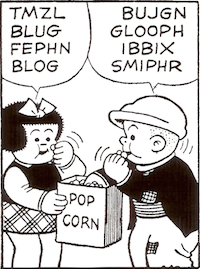From EurekAlert!:
No matter which channel you turn to on television, you are likely to find some kind of visual element that seems to overpower the screen--making it difficult to focus on one thing.That last paragraph is a fine rejoinder to inflated claims about the ability to "multitask" (i.e., lose one's concentration by attempting to focus on too many things at once).
In the past few years, television stations have begun to reformat their screen presentations to include scrolling screens, sports scores, stock prices and current weather news. These visual elements are all designed to give viewers what they want when they want it.
However, Kansas State University professors Lori Bergen and Tom Grimes say that it's not working.
"Our conclusion has been that if you want people to understand the news better, then get that stuff off the screen," Grimes said. "Clean it up and get it off because it is simply making it more difficult for people to understand what the anchor is saying."
Grimes and Bergen are both associate professors of journalism and mass communications. They have collaborated with Deborah Potter, head of the Washington, D.C., research firm Newslab, in a study on distracting visual information. The study focused on viewers' ability to digest content in the presence of distracting information on the screen.
"We discovered that when you have all of this stuff on the screen, people tend to remember about 10 percent fewer facts than when you don't have it on the screen," Grimes said. "Everything you see on the screen--the crawls, the anchor person, sports scores, weather forecast--are conflicting bits of information that don't hang together semantically. They make it more difficult to attend to what is the central message."
For their research, Bergen, Grimes and Potter conducted a series of four experiments that examined people's attention spans regarding complex and simple cognitive processes.
"The outcome of all of the experiments was that people were splitting their attention into too many parts to understand any of the content," Grimes said.
In 1990, Music Cable Television Network, or MTV, made its debut on cable television. Colorful graphics, young video jockeys and hip music seemed to be the key elements that captured viewer's attention.
Robert Pittman, who created MTV, attributed the station's success to the ability of viewers in their late teens and early 20s to process multiple facets of information simultaneously. In television, success brings imitation. When MTV's ratings soared, other stations began to adopt the presentation format. CNN's Headline News was one of the first to transform its screens to showcase more than just the anchor.
"When Mary Lynn Ryan, who was CNN's producer at the time, did this the news ratings skyrocketed," Grimes said. "So it appeared as though Robert Pittman was correct: if you are from 12-22 years old, your brain has learned how to process all these competing messages simultaneously, but people in their 30s and older have not learned how to do that."
Bergen, however, hypothesized that Pittman's theory was not correct. The way people process information is not something that can be learned--rather it is a matter of perceptual grouping.
"The human brain is today as it was in the 1880s, the 1580s and in the time of the Greeks and Romans. It has not changed," Grimes said. "We are no better able to parallel process conflicting information now than we were 300 years ago. So this notion that Pittman had that people have learned how to do that is nonsense."
You can read the rest of the article by clicking here. (Via 43 Folders.)


